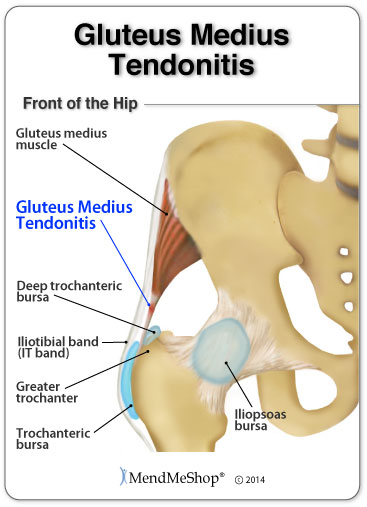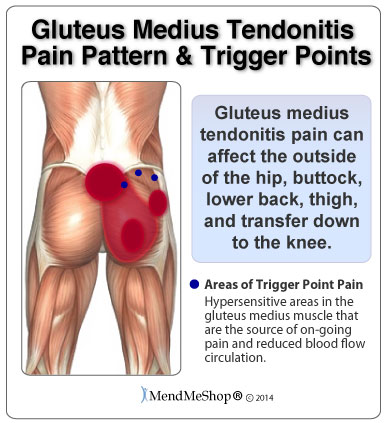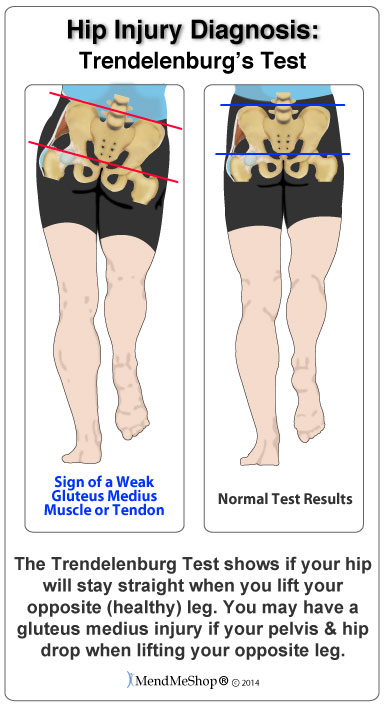The gluteus medius tendon connects the gluteus medius muscle to your pelvis. Its job is to help you move your thigh/leg away from your body and stabilize your hip while walking, running, and jumping.
Gluteus medius tendonitis (sometimes spelled tendinitis and pronounced 'tendinitus') is an injury where your gluteus medius tendon is irritated or inflamed. You will feel this irritation, swelling and inflammation when there is a strain, damage or micro-tearing to the tendon tissue. This injury can happen from overuse of the tendon or an accident of some kind.
The hip is a complicated joint and so if you are suffering from gluteus medius tendonitis it might be hard to tell. Pain can easily be transferred to other areas of the hip, thigh, lower back or buttock. Sometimes pain can even shoot down the side of your leg. If left untreated, gluteus medius tendonitis can turn into a chronic condition or degeneration of your tendon fibers.
Anyone can suffer from tendinitis, but it is most common in adults due to degeneration of tissue as we age. Over time the tendons in the hip will wear down resulting in something called degeneration. This is where the fibers in your tendons will become more weak - it's just a natural process that happens as we age.

Chronic inflammation of the gluteus medius tendon (tendinopathy) that results from many small tears over time from overuse, repetitive movements, or friction from a tight iliotibial band. In many cases, degeneration of the gluteus medius tendon is associated with greater trochanteric bursitis; the combined injury is called greater trochanteric pain syndrome. When chronic gluteus medius tendinitis occurs, the gluteus medius tendon is vulnerable to subsequent injury and degeneration that may result in a tear.
If you have gluteus medius tendonitis you may experience pain over the outermost side of your hip, the upper side of your buttock and even in the lower back at the spine. You may also experience swelling, warmth or redness around your injury and the pain often gets worse by moving your hip. Weakness in your hip and surrounding muscles and loss of range of motion while moving your leg away from the body are also some common symptoms of this condition.

There are many causes to gluteus medius tendonitis, some of which include:
As we stated earlier, hip pain is a very common problem and there are many causes of hip pain. It can become quite a complex job to determine the specific condition that you are dealing with as well as the underlying causes. Are you are having trouble sleeping on that side of your hip? Are you having pain standing, walking are after sitting for any length of time?
The best way to diagnose this condition is with a visit to your doctor for a physical examination of your hip. During a physical examination of your injured hip, your doctor will be looking for weakness and pain in the hip area. Your hips should be at the same level and they may also look at the results of something called the 'Trendelenburg's Test'. This test is done by standing on one leg and allowing the pelvis to drop on the opposite side while lifting your opposite (healthy) leg/hip. Your doctor will know that you have gluteus medius tendonitis (or weakness in your hip muscles) if you lift the opposite (healthy) leg/hip and you're unable to maintain your balance while you stand (you may also experience a shooting pain) (reference: 1, 2).
It's important to have a proper diagnosis from a doctor or some other medical professional to determine the cause of your symptoms. This way the right treatment can be used to treat the condition and relieve your pain.

Tendinosis refers to tendon degeneration when there is no inflammation. Tendinosis is often caused by chronic degeneration (wearing away) of tendon fibers over time and is a natural thing that happens to our tissue as we age. However, Tendinosis is also caused from repetitive use without adequate rest between usage (RSI injury). As an example, achilles tendinosis is quite common in runnners as their achilles is under repetitive stress. In a nutshell, Tendinitis relates to tendon inflammation whereas Tendinosis refers to tendon breakdown with no inflammation.
Where tendonitis means damage or micro-tearing to your tendon, tenosynovitis is damage or micro-tearing to the sheath covering your tendon. This sheath is a protective lining for your tendon and is made up of synovium. If this sheath is injured it can also become irritated resulting in similar symptoms as tendonitis (pain, swelling and inflammation).
It's possible for you to have tendonitis / tendinosis AND tenosynovitis at the same time creating a more complicated hip tendonitis injury.
No one is immune to tendinitis, you can reduce your risk of re-injury with consistent conservative treatments
If you have pain and inflammation in your hip, buttock and/or your tail bone, it's very important to heal your injury quickly and completely. You must avoid the build up of scar tissue. If you don't, your hip tendinitis injury may last for a very long time. This is why it's so important to continuously use conservative treatment tools to heal any recurring tendon damage before it can build into something big. For any hip tendinitis sufferer, having the right tools makes all the difference.
In mild and moderate cases of tendinitis / strained tendons, your PT will most likely encourage you to augment your sessions with conservative home exercises/treatments. Severe injury to the tendon (ruptured tendons) will require surgery to re-attach the tendon to your bone or bring the edges of the tear together. If you suspect that you've ruptured your tendon be sure to speak with your doctor for suggested treatment.
The first step for conservative treatment of your hip tendinitis is to reduce the swelling to "open up" the area for more blood flow. Anyone in the health-care business knows that your blood supplies the oxygen and much needed nutrients required to heal hip tendinitis injuries. This is why for years, doctors, trainers, and other medical professionals have recommended RICE (Rest, Ice, Compression, Elevation) to treat the pain and swelling of fresh injuries, chronic pain, and after any re-injury.
This is important because once blood vessels are blocked or damaged, they can no longer carry oxygenated blood to your damaged tendon and tissues begin to break-down. Without cold compression, tissues break down further because they can't get the oxygen they need to survive. By limiting the amount of damage done to your tendons, you also limit the amount of healing that needs to occur. This is a very important step to heal acute or chronic tendon injuries faster and with less pain.
After the inflammation in your hip has been reduced, providing extra blood flow and strengthening soft tissue in the injured area is recommended.
TShellz Wraps® contain a unique Carbon Fiber Energy Pad which is flexible and will shape to conform to your body. This Energy Pad emits a uniform wave of perfectly safe energy over its entire surface. This energy is absorbed by soft tissue in the treatment area, opening blood vessels, resulting in an increase in blood flow. Increased blood circulation is what your body needs to accelerate the healing of soft tissue and this is why we recommend the TShellz Wrap®.
The TShellz Wrap® is an FDA Registered Medical Device and is suitable for use in therapeutic clinics and FROM HOME. It is completely safe for people and patients to use for themselves.
The technology found in a TShellz Wrap® has been used for decades in the worlds of professional and amateur sports - a contributing factor as to why athletes seem to recover from injuries so quickly.
Have you ever wondered by an athlete can return to activity after 3 or 4 weeks following a soft tissue injury - while your average person takes much longer to return back to normal? The secret isn't really that much of a secret - it involves consistent treatments (meaning multiple times a day) using a treatment like the TShellz Wrap® to stimulate blood flow to the injured tissues. Most athletes have the luxury of using in-house facilities many times per day.
How many us can afford the time and money to visit a clinic multiple times a day? Very few indeed. This is how you can gain some of the advantages that athletes enjoy in their injury recovery - by using a device like the TShellz Wrap® two or three times a day on a consistent basis.
We believe the TShellz Wrap® to be one of the most effective home treatments to increase localized blood flow in and around the treatment area.
We can promise that you will receive a product that is designed to be safe and does what it is supposed to do... reduce pain (as stated in "Therapeutic Heat and Cold", 4th edition. - Ed. Justus F. Lehmann, M.D., Williams, and Wilkin) temporarily increase length & flexibility of soft tissue (as stated in "Therapeutic Heat and Cold", 4th edition. - Ed. Justus F. Lehmann, M.D., Williams, and Wilkin) and aid your body in recovering from tendon, muscle and other soft tissue injuries via enhanced blood flow.
The unit plugs into a standard wall outlet to get its power. The nice thing about the power supply is that the same unit can be used in North America and overseas as well. It has the capability to operate between 110v and 230v.
The TShellz Wrap® has a special signal controller that can be set for 3 different power levels of application (3=High, 2=Medium, 1=Low). The cord is long enough that you can sit or lie comfortably and watch TV, read or surf the net while you're using it.
Treatments are max 30 minutes in duration and the device can be worn over clothing. This allows you to use the device at work, at home, or really anywhere you have access to an electrical outlet.
The most common question we receive from individuals prior to purchasing is - how many times a day should I be using my wrap and when should I be using them? While treatment plans will differ for each individual and their specific injury, there are general guidelines that should be adhered to.
The TShellz Wrap® would then be used:
Conservative treatment tools just like these have been used successfully by thousands of soft tissue injury sufferers - just like you.
We believe the use of TShellz® Circulatory Boost Wraps for boosting blood flow to soft tissue in the area of application is one of the most under-utilized home treatment options available on the market today. We have client after client that have tried many options out there and have been amazed at how effective and fast the TShellz Wrap treatment can relieve pain and increase blood flow in the treatment area.
With regular use of the TShellz® Circulatory Boost Wrap:
*Know that every personal soft tissue injury is unique and the TShellz Wrap may not work for everyone. This is why we offer a 60-day money back return on all our TShellz Wrap devices.
We all know that if the injury was healed, the pain would go away but what about the opposite situation? If the pain is gone, does that mean the injury is better? Unfortunately, this is not always true.
Too many people only focus on suppressing pain symptoms while providing less attention to the true healing aspects of the body. Experiencing less pain, while obviously a good short-term goal, does not equate to underlying healing. Scar tissue can remain for months after one gets to a point of being relatively pain-free. However, as long the weak and brittle scar tissue remains, you are susceptible to re-injury or re-aggravation. Certain motions or movements can cause the weaker tissue to easily tear - resulting in some reversal of the recovery up until that point.
This is why we recommend for people to continue with their doctor or therapist recommended exercises and to continue with mild treatments of the TShellz Wrap® for a period of time - to better ensure complete recovery.
Ongoing treatments to enhance circulation are intended to soothe, relax and promote healing of damaged soft tissue in the application area. T•Shellz treatment also results in the ability of soft tissue to extend further due to the effect of heat on soft tissue. The more extensible your tissues are, the less likely they are to strain or sprain.
People tell us all the time, "I was told that if I stay off my feet for a few weeks, my pain will disappear for good."
The truth is, tendonitis pain is usually a culmination of numerous factors, such as repetitive stress, poor posture, acute injuries, and overcompensation issues resulting from other muscle and soft tissue ailments.
It may take weeks or months for these pain triggers to surface. When they , however, merely resting will solve the underlying issues. You need to utilize actions and options that actually treat the source of the pain and help reverse the damage that has been done.
Resting has a role to play, but it is only one small factor in a recovery plan.
Product Advisors are available 9:00 am to 5:00 pm Eastern Standard Time Monday to Friday.
I want to learn more about Post-Surgery Recovery
I want to learn more about TShellz Wrap® Circulatory Boost
I want to learn more about Ice & Heat: Which Is Better For Treatment?
I want to learn more about Tendonitis Treatments
I want to learn more about Tendonitis Surgery
During your recovery, you will probably have to modify and/or eliminate any activities that cause pain or discomfort at the location of your soft tissue injury until the pain and inflammation settle. The more diligent you are with your treatment and rehabilitation, the faster you will see successful results!
Please be aware that this information is neither intended nor implied to be a substitute for professional medical advice. CALL YOUR HEALTHCARE PROVIDER IMMEDIATELY IF YOU THINK YOU MAY HAVE A MEDICAL EMERGENCY. Always seek the advice of your physician or other qualified health provider before using any of our outstanding products to make sure they are right for you and your condition or if you have any questions regarding a medical condition. Always see your doctor for a proper diagnosis as there are often many injuries and conditions (some very serious) that could be the cause of your pain.
© 2025 In.Genu Design Group, Inc. Contact Us